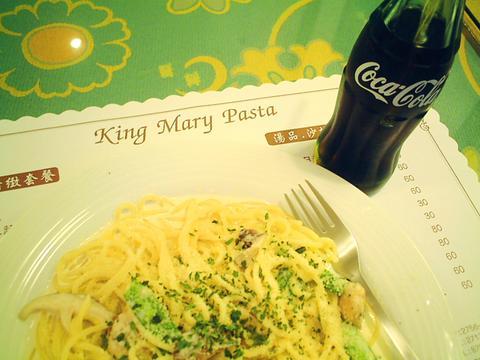There's a long-running debate about where the best Italian food can be found in Taipei. King Mary Pasta can be excluded from the discussion if you' re looking for haute cuisine. If, however, you're wanting a big helping of tasty pasta that weighs more than it costs, King Mary is the place to visit.
With seven locations in the metropolitan area and a menu that tops out under NT$200, Mary's is not so much about fine dining as frenzied feeding. The owners have forgone delicate ambience and decor for the kind of utilitarian esthetic you might find at, say, a Chuck E Cheese's pizza parlor; the kind of place you can hose down after the seven-year-olds' birthday party and reseat within five minutes. It's a shade classier than a traditional white-tiled Taiwanese restaurant; Mary's has red and green tiles thrown in to give it that authentic Italian feel.

PHOTO: DAVID MOMPHARD, TAIPEI TIMES
Mary's instead focuses on filling stomachs with a menu built on vermicelli pasta covered with a variety of sauces and toppings; chicken and snow peas, garlic, asparagus, tomatoes and more. All these dishes are priced at NT$100 and the portions are more than enough to fill you.
And there's over a dozen to choose from, so coming back often won't get boring. A smaller selection or baked pastas is available for NT$130 or, if you're really hungry, a set meal includes Italian-style soup, all the baked garlic bread you can eat, four-seasons fruit salad, your choice of any of the NT$100 pastas and coffee, tea or fruit juice. At NT$190, it's one of the best Western food bargains in town.
Mary's also has a selection of beverages and beers, including Corona and Heineken always on offer for NT$80 per bottle. There are occasionally other beers available for the asking; NT$100 Guinness and Grolsch for example. Check the daily specials board. The most expensive item on Mary's menu is wine. I asked what label it was and was told Californian. Sorry, Mary, I want to know a little more about it if I'm going to pay NT$250 for a glass.

Nov. 11 to Nov. 17 People may call Taipei a “living hell for pedestrians,” but back in the 1960s and 1970s, citizens were even discouraged from crossing major roads on foot. And there weren’t crosswalks or pedestrian signals at busy intersections. A 1978 editorial in the China Times (中國時報) reflected the government’s car-centric attitude: “Pedestrians too often risk their lives to compete with vehicles over road use instead of using an overpass. If they get hit by a car, who can they blame?” Taipei’s car traffic was growing exponentially during the 1960s, and along with it the frequency of accidents. The policy

Hourglass-shaped sex toys casually glide along a conveyor belt through an airy new store in Tokyo, the latest attempt by Japanese manufacturer Tenga to sell adult products without the shame that is often attached. At first glance it’s not even obvious that the sleek, colorful products on display are Japan’s favorite sex toys for men, but the store has drawn a stream of couples and tourists since opening this year. “Its openness surprised me,” said customer Masafumi Kawasaki, 45, “and made me a bit embarrassed that I’d had a ‘naughty’ image” of the company. I might have thought this was some kind

What first caught my eye when I entered the 921 Earthquake Museum was a yellow band running at an angle across the floor toward a pile of exposed soil. This marks the line where, in the early morning hours of Sept. 21, 1999, a massive magnitude 7.3 earthquake raised the earth over two meters along one side of the Chelungpu Fault (車籠埔斷層). The museum’s first gallery, named after this fault, takes visitors on a journey along its length, from the spot right in front of them, where the uplift is visible in the exposed soil, all the way to the farthest

The room glows vibrant pink, the floor flooded with hundreds of tiny pink marbles. As I approach the two chairs and a plush baroque sofa of matching fuchsia, what at first appears to be a scene of domestic bliss reveals itself to be anything but as gnarled metal nails and sharp spikes protrude from the cushions. An eerie cutout of a woman recoils into the armrest. This mixed-media installation captures generations of female anguish in Yun Suknam’s native South Korea, reflecting her observations and lived experience of the subjugated and serviceable housewife. The marbles are the mother’s sweat and tears,